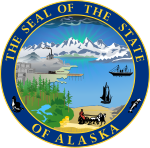Type a search term to find related articles by LIMS subject matter experts gathered from the most trusted and dynamic collaboration tools in the laboratory informatics industry.
| Elections in Alaska |
|---|
 |
The number of elections in Alaska (Iñupiaq: Alaaskam naliġagviat) varies by year, but typically municipal elections occur every year, plus primary and general elections for federal and state offices occur during even-numbered years. Alaska has a gubernatorial election every four years. Members of the state's United States congressional delegation run for election or re-election at the times set out in the United States Constitution. Primary elections assist in choosing political parties' nominees for various positions. On a regional basis (see list of boroughs and census areas in Alaska), elections also cover municipal issues. In addition, a special election can occur at any time.
In a 2020 study, Alaska was ranked as the 15th hardest state for citizens to vote in.[1]
In 2020, Alaskan voters approved an initiative to implement a nonpartisan blanket top-four primary with a single, open primary where candidates from all parties are listed on the ballot and the top four vote-getters advance to the general election.[2] This system went into effect with the 2022 elections. Prior to this, registered voters in Alaska were given a choice between three primary ballots reflecting a semi-closed primary system.[3] Specifically, Democratic, Libertarian, Alaskan Independence and Independent candidates were listed on one ballot available to all registered voters and Republican candidates were listed on a second ballot available to voters registered as Republican, Nonpartisan or Undeclared.[3] In 2024, Alaskans will vote on a measure to repeal the system and return to partisan primaries.[4]
| Year | Republican | Democratic | Third party(ies) | |||
|---|---|---|---|---|---|---|
| No. | % | No. | % | No. | % | |
| 2020 | 189,951 | 52.83% | 153,778 | 42.77% | 15,801 | 4.39% |
| 2016 | 163,387 | 51.28% | 116,454 | 36.55% | 38,767 | 12.17% |
| 2012 | 164,676 | 54.80% | 122,640 | 40.81% | 13,179 | 4.39% |
| 2008 | 193,841 | 59.42% | 123,594 | 37.89% | 8,762 | 2.69% |
| 2004 | 190,889 | 61.07% | 111,025 | 35.52% | 10,684 | 3.42% |
| 2000 | 167,398 | 58.62% | 79,004 | 27.67% | 39,158 | 13.71% |
| 1996 | 122,746 | 50.80% | 80,380 | 33.27% | 38,494 | 15.93% |
| 1992 | 102,000 | 39.46% | 78,294 | 30.29% | 78,212 | 30.26% |
| 1988 | 119,251 | 59.59% | 72,584 | 36.27% | 8,281 | 4.14% |
| 1984 | 138,377 | 66.65% | 62,007 | 29.87% | 7,221 | 3.48% |
| 1980 | 86,112 | 54.35% | 41,842 | 26.41% | 30,491 | 19.24% |
| 1976 | 71,555 | 57.90% | 44,058 | 35.65% | 7,961 | 6.44% |
| 1972 | 55,349 | 58.13% | 32,967 | 34.62% | 6,903 | 7.25% |
| 1968 | 37,600 | 45.28% | 35,411 | 42.65% | 10,024 | 12.07% |
| 1964 | 22,930 | 34.09% | 44,329 | 65.91% | 0 | 0.00% |
| 1960 | 30,953 | 50.94% | 29,809 | 49.06% | 0 | 0.00% |
Alaskans have voted in United States presidential elections since 1960. With the exception of the candidacy of Barry Goldwater in 1964, the Republican Party has carried Alaska in every presidential election.
Alaska has a Class II Senator (currently Dan Sullivan) and a Class III Senator (currently Lisa Murkowski). Alaska first elected Senators in 1956 under the "Alaska–Tennessee Plan." They had no vote in the Senate, but were sent to represent Alaska as if they were, to lobby for statehood, and to assume the office of senator should the situation arise. Alaska's first voting senators were elected in the 1958 election; it was a special election due to the former territory's pending admission as a state.
Alaska has had a single congressional district in the United States House of Representatives since statehood was granted in 1959.
Alaska Senators have terms of four years; half of them are elected every two years. Alaska Representatives have terms of two years; all of them are elected every two years.[6] The state's redistricting process allows the power to shorten the terms of state senators should a redistricting action substantially alter their district.
Virtually all of the state's municipalities hold their general elections in early October, with the notable exception of Anchorage. North Pole for many years held their elections in November, in the process holding them on the same day as state elections on even-numbered years, but eventually abandoned that in favor of October elections. Anchorage switched from an early October election day to one in early April around 1992.
There are four qualified political parties.[7]
Lawsuits launched by Joe Vogler and Jim Sykes, among other lawsuits, led the Alaska Legislature to eventually revamp and relax laws pertaining to party status and ballot access. The first instance of a minor party gaining recognition came in 1982, when the gubernatorial candidacy of Dick Randolph under the Libertarian Party was successful enough to meet the existing party recognition threshold.
Alaska law allows a political party to select who may participate in their party's primary.
State legislation related to the administration of elections introduced in 2011 through this year, 2020